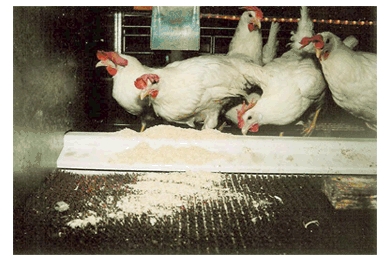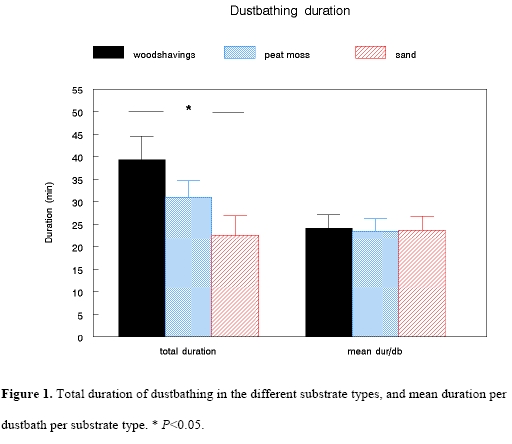Definitions of behavioural indicators for evaluating substrate quality
In Deliverable 4.4 the development of a set of behavioural criteria to evaluate the substrate quality in different housing systems for laying hens will be described. These criteria were developed using two approaches: firstly a short literature overview on problems associated with quality or availability of substrate and secondly an experimental approach.
Substrate in laying hen housing systems
A number of studies have investigated substrate-directed behaviour in laying hens, in particular dustbathing. It has been shown that domestic hens are attracted to substrate and show a preference for substrate as a floor type (Dawkins, 1981; Dawkins, 1983; Matthews et al., 1995). Hens housed in battery cages are deprived of substrate and it has been shown that this increases the risk of outbreaks of feather pecking and cannibalism. 
The Council Directive 1999/74/EC laying down minimum standards for the protection of laying hens states that hens should be housed in furnished (enriched) cages or non-cage systems from 2012 onwards. Non-cage (alternative) systems should have at least 250 cm2 area with substrate per hen and in furnished cages hens should be provided with substrate such that pecking and scratching are possible (CEC, 1999). However, especially in furnishedcages the substrate area is a point of discussion as it is often a small area and only small amounts of substrate are provided (Appleby et al., 2002). It is seriously questioned if this substrate area fulfils the need of the hens with respect to substrate related behaviours like foraging and dustbathing. Sham dustbathing is often seen and it does not reduce the motivation to dustbathe in litter (Olsson et al., 2002b) which may suggest that the litter as provided in furnished cages does not fulfil the needs of the hens. In addition it has been observed that hens in furnished cages have a low motivation for using the litter areas to dustbath (Olsson and Keeling, 2002).
In a large study on different types of furnished cages it was observed that the substrate areas were frequently used but not as much as in Non-cage housing systems (Appleby et al., 2002).
Although the substrate area per bird in non-gage systems (aviaries, free range systems, organic systems) is much larger as compared to furnished cage systems it has been questioned if these litter areas do fulfil the needs of the hens. Abnormal behaviour related to the availability or quality of substrate has also been observed in these systems, like feather pecking and sham dustbathing (Fiks, personal communication; Oden et al., 2002). Oden et al. (2002) concluded that the substrate area was insufficient in two types of aviary systems. They observed a high frequency of aggressive pecks in substrate areas that might be related to the preference of birds to space out when foraging which was not possible due to the limited substrate space per bird (Keeling and Duncan, 1991, in Oden et al., 2002). Litter quality was poor in these aviary systems, especially at the end of the laying period, and fewer birds used the litter for dustbathing when it became less friable (Oden et al., 2002).
Behaviours associated with availability and quality of substrate
From the huge amount of literature on the causation of feather pecking in domestic fowl it becomes clear that the provision of good foraging material may reduce the prevalence of feather pecking (e.g., Huber-Eicher and Wechsler, 1997; 1998; Wechsler and Huber-Eicher, 1998; Aerni et al., 2000; El-Lethey et al., 2000; El-lethey et al., 2001; Nicol et al., 2001). However, feather pecking may be caused by multiple environmental factors like light intensity, group size and stocking density, food form and rearing conditions (see e.g. overview in Blokhuis and Wiepkema, 1989). The prevalence of feather pecking may be used as indicator of substrate quality but should therefore be combined with other behavioural measures. In addition to feather pecking the frequency of aggressive pecks in the substrate area may be related to overcrowding in the litter area (Oden et al., 2002) and may thus be used as criterion to assess substrate quality.
In the absence of suitable substrate for dustbathing sham dustbathing may be observed (Lindberg and Nicol, 1997; Olsson et al., 2002b) which thusmay be used as a criterion to assess substrate quality. In addition, as also described in Deliverable 3.1., in a substrate preferred for dustbathing the duration of a dustbath is longer as compared to substrate less preferred for dustbathing (Van Liere et al., 1990), and there is a greater probability of complete dustbaths (Van Liere et al., 1990; Vestergaard et al., 1990; Van Liere and Siard, 1991).
Laying hens have an innate behavioural rhythm for certain behaviours (like feeding, dustbathing, foraging or perching) (e.g., Oden et al., 2002) and therefore the opportunity to perform these behaviours at the right time may be an important criterion to assess the quality of the substrate area. Under natural conditions laying hens synchronise these behaviours (Mench and Keeling, 2001). Thus, the number of hens performing foraging and dustbathing on the litter area in the preferred periods (middle of the light period for dustbathing and before lights off for foraging, see Deliverable 3.3) may reflect the accessibility of the substrate area in housing systems (Oden et al., 2002).
| Description | download |
| 4.4 Definitions of behavioural indicators for evaluating substrate quality |